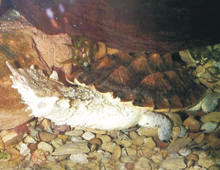Description: Mata mata turtles are flat freshwater turtles. Their rough, oblong carapace (top part of the shell) is dark brown to mahogany and the plastron (bottom part of the shell) is yellow and brown colored. On the carapace there are rows of conical scutes. The fleshy parts of the adults – the head, neck, tail and limbs are grayish brown. They have a large, flat, triangular head with tubercles; a long snout and a very wide mouth; a long neck with many protuberances and small skin flaps along both sides; small eyes, thick tails and five webbed claws on each forefoot. Males and females differ in appearance with regards to their plastron and tails – males plastron is concave and tails are thicker.
Size: They are large turtles, measuring up to 18 inches (45 cm) in length and weighing as much as 33 pounds (15 kg).
Behavior: Their appearance, resembling a pile of rotting leaves serves them well, camouflaging them from prey and potential predators. They have a unique hunting technique. When unaware small fish swim too close, they disappear instantly — sucked in by a powerful vacuum created when the Mata mata turtle opens its jaws. While the prey is going in, water is being expelled. They rarely swim, preferring to walk underwater, taking air at the surface through the unique proboscis in front of their tiny eyes. They are solitary except for breeding.
Diet: This carnivorous turtle feeds mainly on fish and aquatic invertebrates. They might also eat birds and small mammals that have gotten into the water.
Senses: Mata mata turtles have poor eyesight. They rely on their auditory and tactile senses that are excellent to find prey and warn them of predators. On both sides of their head they have a thin membrane, tympanum, that can sense auditory stimuli. The folds of skin along the body contains highly sensitive sensory nerves that are capable of detecting motion. Also the neck is sensitive to pressure waves, thus detecting the movement of fish that are nearby.
Communication: Males have courtship displays. They extend their head toward the female while opening and shutting their mouths.
Reproduction: After mating, the female comes on land and lays eggs in a nest she has excavated in decaying vegetation at the forest edge. Her clutch contains 12 to 28 round, brittle shelled eggs. The nest is not guarded and the incubation period is rather lengthy, about 200 days.
Habitat/range: They live in shallow areas on the bottom of calm, slow moving bodies of water in the northern area of South America; around the Amazon and Orinoco River basins.
Status: Not evaluated for IUCN or CITES.



